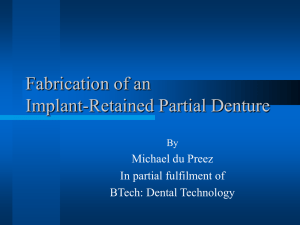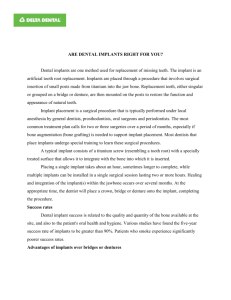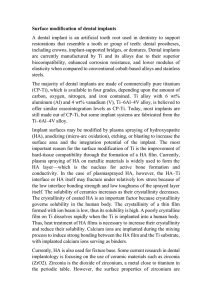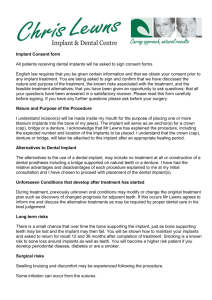Document 14240043
advertisement
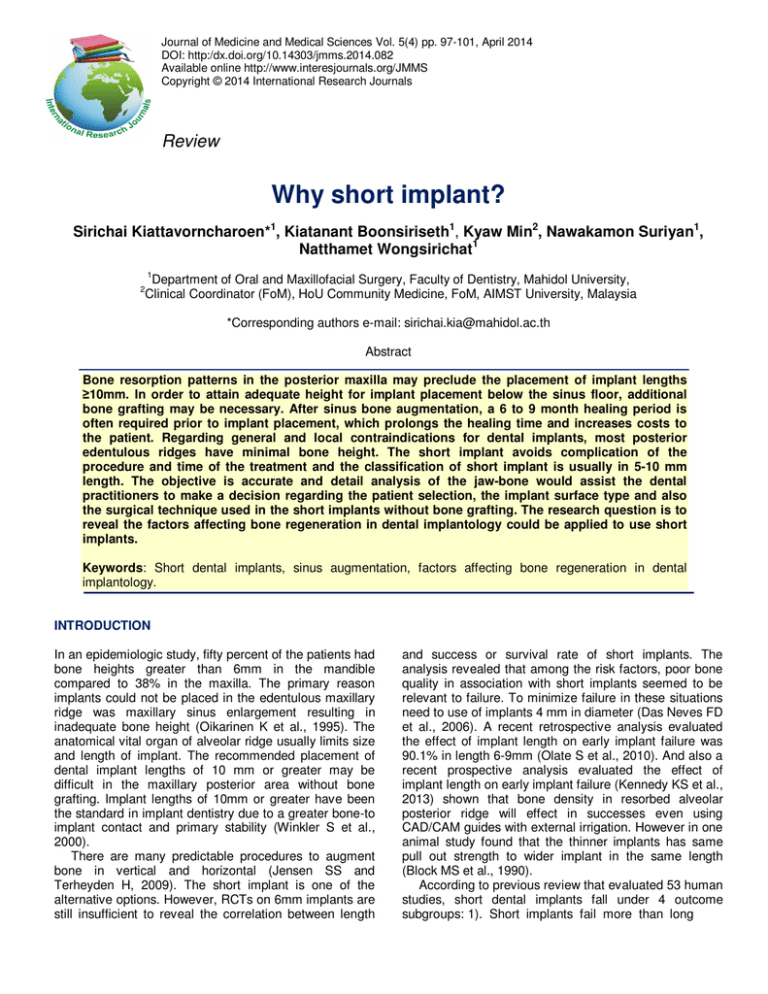
Journal of Medicine and Medical Sciences Vol. 5(4) pp. 97-101, April 2014 DOI: http:/dx.doi.org/10.14303/jmms.2014.082 Available online http://www.interesjournals.org/JMMS Copyright © 2014 International Research Journals Review Why short implant? Sirichai Kiattavorncharoen*1, Kiatanant Boonsiriseth1, Kyaw Min2, Nawakamon Suriyan1, Natthamet Wongsirichat1 1 Department of Oral and Maxillofacial Surgery, Faculty of Dentistry, Mahidol University, Clinical Coordinator (FoM), HoU Community Medicine, FoM, AIMST University, Malaysia 2 *Corresponding authors e-mail: sirichai.kia@mahidol.ac.th Abstract Bone resorption patterns in the posterior maxilla may preclude the placement of implant lengths ≥10mm. In order to attain adequate height for implant placement below the sinus floor, additional bone grafting may be necessary. After sinus bone augmentation, a 6 to 9 month healing period is often required prior to implant placement, which prolongs the healing time and increases costs to the patient. Regarding general and local contraindications for dental implants, most posterior edentulous ridges have minimal bone height. The short implant avoids complication of the procedure and time of the treatment and the classification of short implant is usually in 5-10 mm length. The objective is accurate and detail analysis of the jaw-bone would assist the dental practitioners to make a decision regarding the patient selection, the implant surface type and also the surgical technique used in the short implants without bone grafting. The research question is to reveal the factors affecting bone regeneration in dental implantology could be applied to use short implants. Keywords: Short dental implants, sinus augmentation, factors affecting bone regeneration in dental implantology. INTRODUCTION In an epidemiologic study, fifty percent of the patients had bone heights greater than 6mm in the mandible compared to 38% in the maxilla. The primary reason implants could not be placed in the edentulous maxillary ridge was maxillary sinus enlargement resulting in inadequate bone height (Oikarinen K et al., 1995). The anatomical vital organ of alveolar ridge usually limits size and length of implant. The recommended placement of dental implant lengths of 10 mm or greater may be difficult in the maxillary posterior area without bone grafting. Implant lengths of 10mm or greater have been the standard in implant dentistry due to a greater bone-to implant contact and primary stability (Winkler S et al., 2000). There are many predictable procedures to augment bone in vertical and horizontal (Jensen SS and Terheyden H, 2009). The short implant is one of the alternative options. However, RCTs on 6mm implants are still insufficient to reveal the correlation between length and success or survival rate of short implants. The analysis revealed that among the risk factors, poor bone quality in association with short implants seemed to be relevant to failure. To minimize failure in these situations need to use of implants 4 mm in diameter (Das Neves FD et al., 2006). A recent retrospective analysis evaluated the effect of implant length on early implant failure was 90.1% in length 6-9mm (Olate S et al., 2010). And also a recent prospective analysis evaluated the effect of implant length on early implant failure (Kennedy KS et al., 2013) shown that bone density in resorbed alveolar posterior ridge will effect in successes even using CAD/CAM guides with external irrigation. However in one animal study found that the thinner implants has same pull out strength to wider implant in the same length (Block MS et al., 1990). According to previous review that evaluated 53 human studies, short dental implants fall under 4 outcome subgroups: 1). Short implants fail more than long 98 J. Med. Med. Sci. implants; 2) Short implants have increased failure rates but adequate survival rate; 3) Short implant lengths did not have any significant influence on survival rate, and; 4) Survival rates are similar in short and long implants (88100%). And the macro and micro design may play a role in osseointegration regardless of the implant length (Renouard F et al., 2006; Feldman S et al., 2004). Moreover, maximum bone stress is practically independent of implant length (Pierrisnard L et al., 2003). Even that implant width is more important than the additional length (Anitua E et al., 2010), recent studies, however, suggested that short implants (7 to <10 mm) can reach similar success rates as longer ones for the support of fixed partial dental prostheses (Griffin TJ et al., 2004). Even 3-year (Bernard JP et al., 1995) and 7-year (Nedir R et al., 2004) follow-up studies reported retrospectively that short implants (8 to 9mm long) (Renouard F et al., 2005; Sharan A et al., 2008; Van Assche N et al., 2012) were not less successful compared with implants >10mmlong in the posterior region with fixed partial dental prostheses. In one of the study researchers followed a total of 630 Straumann implants in 264 patients, included 6-mm (n = 35) and 8mm (n = 141) implants for patients with limited bone height (Arlin ML, 2006) and found that the success rates in 2 year were 94.3%, 99.3%, and 97.4% for 6-mm, 8-mm was comparable with longer in 10- to 16-mm implants. The short implants, defined as 10 mm or less, constituted 60% of all failed implants. In one prospective multicenter clinical trial in machined surface, included 26% of 7-mm implants (n = 27), 19% of 8.5-mm implants (n = 70), and 9% of 10-mm implants (n = 475). And found that cumulative success rates were 88.7% for short implants at 6 years and 93.1% for long implants at 5 years. In the prospective clinical trial, to reveal implant success rates relative to length for 429 hydroxyl apatite coated implants, 5-year success rate among 121 patients, found that for 8, 10, 13, 15, and 18 mm implants were showed success rates of 80%, 88.3%, 98.2%, 96.9%, and 100%, respectively (McGlumphy EA et al., 2003). All failures with short implant occurred before loading implant. Several classification systems and procedures were proposed for assessing the bone quality and predicting prognosis as mechanical behaviour of bone is a vital factor in the success and maintenance of osteointegration (Friberg H et al., 1999). Anatomical sites of jaw bones Bone anatomy in the maxilla Tooth to alveolar relationship in the maxilla, skeletal patterns influence the interpretation of tooth position versus jaw bone position using CT studies. The important anatomical vital organ effect to treatment plan is the maxillary sinus. Maxillary basal bone relationships: The alveolar bone and basal ridge often diverge from each other. This inappropriateness will influence for socket preservation as the more divergent the alveolus becomes, the thinner the facial alveolar bone and the higher resorption following tooth loss (Nevins M et al., 2006; Schropp L et al., 2003) . Bone quality: The maxillary bone quality has been described as less dense when compared with the mandible. They found that the anterior mandible had densest bone, followed by the posterior mandible, anterior maxilla, and posterior maxilla (Lekholm U. aZG 1985). Bone anatomy in the mandible Tooth to alveolar relationship in the mandible: Similar to the maxillary position of mandibular teeth is commonly divergent to the position of the basal bone. The important anatomical vital organ effect to treatment plan is inferior alveolar nerve. Factor affecting implantology bone regeneration in dental Several characteristics of bone tissue have been identified as important factors for the successful outcome of dental implant treatment. However, the importance of various parameters of bone quality is not yet fully understood. The term bone quality is complex and includes microscopic, morphological and molecular parameters (Lindh C et al., 2004). Thus, no consensual definition of bone quality has been reached in the literature or implemented in the clinical setting (RibeiroRotta RF et al., 2007; Ribeiro-Rotta RF et al., 2011; Pereira AC et al., 2013). The literature has shown many factors affecting bone regeneration in dental implantology (Elias CN, 2011). It can apply to use in the short implants. Moreover, host defence to age, gender, smoking habits, alcohol and other drug abuse, as well as medical conditions such as diabetes, osteoporosis, cytostatic treatment or radiotherapy, impaired immune defence, psychological disorders and bruxism can cause early implant failures (Esposito M et al., 1998; Ekfeldt A et al., 2001). Biomechanics implant surface morphology and biocompatibility influence proliferation, differentiation and extracellular matrix synthesis that allow adhesion and cell growth. The contaminants which are mainly alumina particles used in the sand blasting of the implant surface are toxic and can lead to cell apoptosis. The existence of metallic chips during implant insertion into the cavity can also compromise the osseointegration (Jayaraman M et al., 2004). Regarding the shape and dimensions of the implant, Kiattavorncharoen et al. 99 Table 1. Lekholm and Zarb Classification Types of bone Description type 1 almost entirely comprised of homogenous compact bone type 2 type 3 thick layer of compact bone surrounding a core of dense trabecular bone thin layer of cortical bone surrounding a core of dense trabecular bone type 4 Thin layer of cortical bone surrounding a core of low-density trabecular bone coupled with the surgeon’s tactile perception. the factors that affect mechanical interlocking are associated to the implant shape, surface irregularities and roughness, holes and grooves, and type and number of screw threads. In case use short implants in the posterior in function the number of the short implants should be considered. Rossi et al. evaluated prospectively the clinical and radiographic outcomes of 40 implants (SLActive, Straumann) with a length of 6mm and moderately rough surface supporting single crowns in the posterior regions. The implants were loaded after 6 weeks of healing. Implant survival rate, marginal bone loss, and resonance frequency analysis (RFA) were evaluated at different intervals. The clinical crown/implant ratio was also calculated. They obtained a survival rate of 95% before loading. No further technical or biological complications were encountered during the 2-year follow up. The mean marginal bone loss before loading was 0.34 to 0.38 mm. After loading, the mean marginal bone loss was 0.23 to 0.33 and 0.21 to 0.39mm at the 1-year and 2-year follow ups. They reported that clinical crown/implant ratio increased with time from 1.5 at the delivery of the prosthesis to 1.8 after 2 years of loading (Rossi F et al., 2010). The surgical technique and the loading conditions influence the stability of the implants and the maintenance of osseointegration. Dental implants are primarily stability in bone by mechanical interlocking. For axial loading is transmitted to the bone according to the threads. Excessive trauma during surgery may affect the bone-to-implant interface, decreasing the osseointegration (Ercoli C et al., 2004). The primary bone repair is contact healing of the receptor bed which plays a fundamental role in osteointegration (Albrektsson T et al., 1981). To preserve tissue viability at implant placement, it is necessary to prepare the surgical bed adequately (Benington IC et al., 2002; Yacker MJ et al., 1996). The quality and quantity of the bone: The local risk factors were considered as density, and implant stability. vessels than the other three types, and therefore it is more dependent on the periosteium for its nutrition. The quality and quantity of the bone: The local risk factors were considered as interdental space, infected sites, and soft tissue thickness, width of keratinized soft tissue, bone density, and implant stability. Healing bone during implant placement Osseointegration determine as a histological perform structural and functional direct contact between bone and bone marrow with Ti-based implants without fibrous tissue. The osteotomy procedure will heal with intramembranous ossification without cartilage tissue formation. Osseointegration of titanium implant surfaces is dependent upon both physical and chemical properties (Ribeiro-Rotta RF et al., 2011). The thickness of crestal bone and the surface of a load-carrying implant, is critical for implant stability, and is considered a prerequisite for implant loading and long-term clinical success of endosseous dental implants (Miyamoto I et al., 2005). Bone remodelling is a complex process regulated by hormones and growth factors. Healthy bone is a dynamic tissue, continually resorping bone and replacing it with new bone in discrete areas know as basic multicellular units, also called bone metabolic units (BMU). The activation of osteoclasts, resorption of old bone, recruitment of osteoblasts, formation of new bone matrix, and mineralisation. On the cancellous surfaces, a BMU does not just dissolve a pit on the surface, but it spreads across the surface leaving behind an area filled with new bone. In the cortex the osteoclasts form a cutting edge and bore through the solid bone, and osteoblasts follow, filling in the tunnels and leaving behind a small vascular channel. Healing soft- tissue during implant placement Classification of type of bone The cortical lamellar bone may heal with little interim woven bone formation, ensuring excellent bone strength while healing to the implant. D1 bone has fewer blood After 1 day probing separate of the periimplant mucosal tissue found the epithelial attachment of approximately 0.5 mm in the apico-coronal. The length of the epithelial adaptation showed a tendency to increase over time was completed at day 5 (day 2: 1.15 mm, day 3: 1.52 mm, 100 J. Med. Med. Sci. day 5: 1.92 mm). The mean length of epithelial attachment shows 1.69 mm (Etter TH et al., 2002). 1. Quality (keratinise tissue) That important for cleaning should be at least 1-1.5 mm. for long term stability. 2. Qualtity (thick or thin biotype) The thickness to protect bone resorption should be 1.8-3.9 mm (Palacci P et al., 2008). In thin biotype in case 0.2-0.8 mm, the soft thickness around implant should be considered in thin (tissue thickness less than 2 mm) (Albrektsson T et al., 1981). To avoid complex surgical procedures in posterior regions, short implants have been predictable documented (Friberg B et al., 2000). The wide in diameter is another choice to achieve the success (Langer B et al., 1993). And the clinical practice short implant today is screw-type with microrough surface. DISCUSSION There are more failures in the highly bone density and it may be related to overheating when combine with CAD/CAM surgical guide (Kennedy KS et al., 2013). Also may be concern with the thickness of the cortical bone that will have less of blood supply. For the short implant, it is difficult to get primary stability in poor quality bone. In dense bone external or internal irrigation by cool saline with intermittent pressure on the drills, every 3 to 5 seconds, new drills, and an incremental drill sequence can promote osteointegration (Misch CE et al., 1999). The reduction of heat generation at the implant site by using rotary instruments at 2500 rpm may decrease osseous damage (Misch CE et al., 1999) Autogenous bone can be used in block form or particulate. There has been interest in reducing the healing time after surgery and loading the implants with oral forces safely. In order to shorten the healing time, the strategy is to alter the biocompatibility of titanium implant surfaces, modify the surgical techniques and change the implant designs. CONCLUSIONS The success rate of short implants varies from 80% to 96% up to surface characteristics, surgical technique, abutment connection, Prosthodontics design, force distribution. Placing short dental implants 8mm or less without bone augmentation may be possible and less complications but need surgical experienced to achieve the primary stability. However, long-term data on survival and performance of short dental implants is required. REFERENCES Albrektsson T, Branemark PI, Hansson HA, Lindstrom J (1981) Osseointegrated titanium implants. Requirements for ensuring a long-lasting, direct bone-to-implant anchorage in man. Acta Orthop Scand.; 52(2):155-170. Anitua E, Tapia R, Luzuriaga F, Orive G (2010) Influence of implant length, diameter, and geometry on stress distribution: a finite element analysis. Int. J. Periodontics Restorative Dent. Feb; 30(1):89-95. Arlin ML (2006). Short dental implants as a treatment option: results from an observational study in a single private practice. Int J Oral Maxillofac Implants. Sep-Oct; 21(5):769-776. Benington IC, Biagioni PA, Briggs J, Sheridan S, Lamey PJ (2002). Thermal changes observed at implant sites during internal and external irrigation. Clin Oral Implants Res.; 13(3):293-297. Bernard JP, Belser UC, Martinet JP, Borgis SA (1995). Osseointegration of Branemark fixtures using a single-step operating technique. A preliminary prospective one-year study in the edentulous mandible. Clin Oral Implants Res. Jun; 6(2):122-129. Block MS, Delgado A, Fontenot MG (1990). The effect of diameter and length of hydroxylapatite-coated dental implants on ultimate pullout force in dog alveolar bone. J Oral Maxillofac Surg. Feb 1990;48(2):174-178. Das Neves FD, Fones D, Bernardes SR, do Prado CJ, Neto AJ (2006). Short implants--an analysis of longitudinal studies. Int J Oral Maxillofac Implants. Jan-Feb;21(1):86-93. Elias CN (2011). Factors Affecting the Success of Dental Implants. Ekfeldt A, Christiansson U, Eriksson T, Lindén U, Lundqvist S, Rundcrantz T. (2001) A retrospective analysis of factors associated with multiple implant failures in maxillae. Clin Oral Implants Res. Oct;12(5):462-467. Ercoli C, Funkenbusch PD, Lee HJ, Moss ME, Graser GN (2004). The influence of drill wear on cutting efficiency and heat production during osteotomy preparation for dental implants: a study of drill durability. Int J Oral Maxillofac Implants. May-Jun; 19(3):335-349. Esposito M, Hirsch JM, Lekholm U, Thomsen P (1998) Biological factors contributing to failures of osseointegrated oral implants. (I). Success criteria and epidemiology. Eur J Oral Sci. Feb; 106(1):527551. Etter TH, Hakanson I, Lang NP, Trejo PM, Caffesse RG (2002) Healing after standardized clinical probing of the perlimplant soft tissue seal: a histomorphometric study in dogs. Clin Oral Implants Res. Dec; 13(6):571-580. Feldman S, Boitel N, Weng D, Kohles SS, Stach RM (2004). Five-year survival distributions of short-length (10 mm or less) machinedsurfaced and Osseotite implants. Clin Implant Dent Relat Res.6(1):16-23. Friberg H, Connern C, Halestrap AP, Wieloch T (1999). Differences in the activation of the mitochondrial permeability transition among brain regions in the rat correlate with selective vulnerability. Journal of Neurochemistry. Jun; 72(6):2488-2497. Friberg B, Grondahl K, Lekholm U, Branemark PI (2000). Long-term follow-up of severely atrophic edentulous mandibles reconstructed with short Branemark implants. Clin Implant Dent Relat Res.; 2(4):184-189. Griffin TJ, Cheung WS (2004). The use of short, wide implants in posterior areas with reduced bone height: a retrospective investigation. J Prosthet Dent. Aug;92(2):139-144. Jayaraman M, Meyer U, Buhner M, Joos U, Wiesmann HP (2004). Influence of titanium surfaces on attachment of osteoblast-like cells in vitro. Biomaterials. Feb; 25(4):625-631. Jensen SS, Terheyden H (2009). Bone augmentation procedures in localized defects in the alveolar ridge: clinical results with different bone grafts and bone-substitute materials. Int J Oral Maxillofac Implants. 2009; 24 Suppl:218-236. Kennedy KS, Jones EM, Kim DG, McGlumphy EA, Clelland NL (2013). A prospective clinical study to evaluate early success of short implants. Int. J. Oral Maxillofac Implants. Jan-Feb ;28(1):170-177. Langer B, Langer L, Herrmann I, Jorneus L (1993). The wide fixture: a solution for special bone situations and a rescue for the compromised implant. Part 1. Int J Oral Maxillofac Implants.; 8(4):400-408. Lekholm U. aZG (1985). Patient selection and preparation. Tissue integrated prostheses: osseointegration in clinical dentistry. Quintessence Publishing Company, Chicago, USA.:199-209. Kiattavorncharoen et al. 101 Lindh C, Obrant K, Petersson A (2004). Maxillary bone mineral density and its relationship to the bone mineral density of the lumbar spine and hip. Oral Surg Oral Med Oral Pathol Oral Radiol Endod. Jul;98(1):102-109. McGlumphy EA, Peterson LJ, Larsen PE, Jeffcoat MK (2003). Prospective study of 429 hydroxyapatite-coated cylindric omniloc implants placed in 121 patients. Int J Oral Maxillofac Implants. JanFeb;18(1):82-92. Misch CE, Qu Z, Bidez MW (1999). Mechanical properties of trabecular bone in the human mandible: implications for dental implant treatment planning and surgical placement. J Oral Maxillofac Surg. Jun;57(6):700-706; discussion 706-708. Miyamoto I, Tsuboi Y, Wada E, Suwa H, Iizuka T (2005). Influence of cortical bone thickness and implant length on implant stability at the time of surgery--clinical, prospective, biomechanical, and imaging study. Bone. Dec; 37(6):776-780. Nedir R, Bischof M, Briaux JM, Beyer S, Szmukler-Moncler S, Bernard JP (2004). A 7-year life table analysis from a prospective study on ITI implants with special emphasis on the use of short implants. Results from a private practice. Clin Oral Implants Res. Apr;15(2):150-157. Nevins M, Camelo M, De Paoli S, Friedland B,Schenk RK,ParmaBenfenati S. (2006) A study of the fate of the buccal wall of extraction sockets of teeth with prominent roots. Int J Periodontics Restorative Dent. Feb ;26(1):19-29. Oikarinen K, Raustia AM, Hartikainen M (1995). General and local contraindications for endosseal implants--an epidemiological panoramic radiograph study in 65-year-old subjects. Community Dent Oral Epidemiol. Apr; 23(2):114-118. Olate S, Lyrio MC, de Moraes M, Mazzonetto R, Moreira RW (2010). Influence of diameter and length of implant on early dental implant failure. J. Oral Maxillofac Surg. Feb 2010; 68(2):414-419. Palacci P, Nowzari H (2008). Soft tissue enhancement around dental implants. Periodontology 2000.; 47:113-132. Pereira AC, Souza PP, Souza JA, Silva TA, Batista AC, Ribeiro-Rotta RF (2013). Histomorphometrical and molecular evaluation of endosseous dental implants sites in humans: correlation with clinical and radiographic aspects. Clinical oral implants research. Apr; 24(4):414-421. Pierrisnard L, Renouard F, Renault P, Barquins M (2003). Influence of implant length and bicortical anchorage on implant stress distribution. Clin. Implant Dent Relat Res. 5(4):254-262. Renouard F, Nisand D (2005). Short implants in the severely resorbed maxilla: a 2-year retrospective clinical study. Clin Implant Dent Relat Res.;7 Suppl 1:S104-110. Renouard F, Nisand D (2006). Impact of implant length and diameter on survival rates. Clin Oral Implants Res. Oct; 17 Suppl 2:35-51. Ribeiro-Rotta RF, Lindh C, Rohlin M (2007). Efficacy of clinical methods to assess jawbone tissue prior to and during endosseous dental implant placement: a systematic literature review. Int J Oral Maxillofac Implants. Mar-Apr; 22(2):289-300. Ribeiro-Rotta RF, Lindh C, Pereira AC, Rohlin M (2011). Ambiguity in bone tissue characteristics as presented in studies on dental implant planning and placement: a systematic review. Clin. Oral Implants Res.; 22(8):789-801. Rossi F, Ricci E, Marchetti C, Lang NP, Botticelli D (2010). Early loading of single crowns supported by 6-mm-long implants with a moderately rough surface: a prospective 2-year follow-up cohort study. Clin Oral Implants Res. Sep; 21(9):937-943. Schropp L, Wenzel A, Kostopoulos L, Karring T (2003). Bone healing and soft tissue contour changes following single-tooth extraction: a clinical and radiographic 12-month prospective study. Int J Periodontics Restorative Dent. Aug; 23(4):313-323. Sharan A, Madjar D (2008). Maxillary sinus pneumatization following extractions: a radiographic study. Int J Oral Maxillofac Implants. Jan-Feb;23(1):48-56. Sharawy M, Misch CE, Weller N, Tehemar S (2002). Heat generation during implant drilling: the significance of motor speed. J Oral Maxillofac Surg. Oct;60(10):1160-1169. Van Assche N, Michels S, Quirynen M, Naert I. (2012) Extra short dental implants supporting an overdenture in the edentulous maxilla: a proof of concept. Clin Oral Implants Res. May; 23(5):567-576. Winkler S, Morris HF, Ochi S (2000). Implant survival to 36 months as related to length and diameter. Ann Periodontol. Dec 2000; 5(1):2231. Yacker MJ, Klein M (1996). The effect of irrigation on osteotomy depth and bur diameter. Int J Oral Maxillofac Implants. Sep-Oct; 11(5):634-638. How to cite this article: Kiattavorncharoen S, Boonsiriseth K, Min K, Suriyan N, Wongsirichat N(2014). Why short implant?. J. Med. Med. Sci. 5(4):97-101



